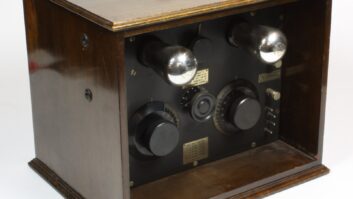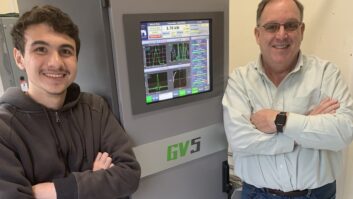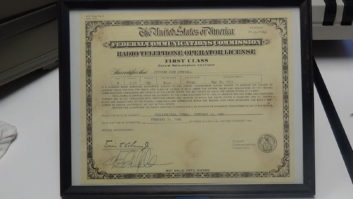“By any objective measure, we’ve hit the ground running.”
Chairman Ajit Pai paused to review the FCC’s actions during his first 100 days as chairman. His title: “Bringing the Benefits of the Digital Age to All Americans.”
He spoke at the American Enterprise Institute, which recently moved into the historic McCormick Apartments building in Washington, now renamed the Daniel A. D’Aniello Building. He was introduced by Jeffrey Eisenach, a member of President Trump’s tech transition team, who hailed Pai for putting in place “commonsense procedural reforms” and taking a “regulatory weed wacker to the regulatory underbrush.” On more substantive issues Eisenach compared Pai to former Chairman Bill Kennard, celebrating their commitments to favoring a “competition-based, enforcement-based framework” for the FCC.
Below are Pai’s full remarks as prepared for delivery and distributed by his office, which also published a bullet point summary of its actions (read that here).
Watch the speech here; read the transcript below:
“Bringing the Benefits of the Digital Age to All Americans.”
It’s great to be back at the American Enterprise Institute. Being here today reminds me that 2016 was a time of great change in Washington. Looking back, it’s clear that we witnessed a momentous event—one that I am sure caused many people great consternation, brought tremendous joy to others, and required a lot of people to pack up their offices and move out. I am referring, of course, to AEI’s decision to move into this wonderful new space after many years on 17th Street.
But in all seriousness, AEI and its scholars are doing tremendous work by making the case for expanding freedom, extending individual opportunity, and strengthening America’s free enterprise system. In particular, AEI has shown thought leadership on communications policy, and much of the credit goes to Jeff Eisenach. Thank you, Jeff, for your scholarship and friendship.
Earlier this week, we reached the 100-day mark of my tenure as FCC Chairman. It sure doesn’t feel like 100 days! Time flies much more quickly in this job than it did when I was in the minority.
By any objective measure, we’ve hit the ground running and have had a very productive three-plus months at the Commission. Just one data point: In my first 100 days, the FCC adopted 49 items. To put that number in perspective, during the prior two permanent Chairmen’s first 100 days, the Commission adopted 25 and 34 items.
But as legendary UCLA basketball coach John Wooden once said, “Never mistake activity for achievement.” So I thought it would be helpful this morning to highlight some of the actions we’ve taken and explain how they fit into a broader strategic vision. That vision includes five important goals: closing the digital divide; modernizing our rules; promoting innovation; protecting consumers and public safety; and improving the agency’s operations. These are the goals I’ve emphasized since I arrived at the FCC in 2012. These are the goals that shaped my first 100 days as Chairman. And these are the goals that I hope will be the agency’s beacon for the next 1,000 days and beyond.
Let’s start with closing the digital divide.
On my first full day as Chairman, I delivered remarks to the Commission’s talented staff. I focused on one issue: bringing the benefits of the digital age to all Americans. This principle goes back to the Commission’s founding statute. Section 1 of the Communications Act of 1934 charged the FCC with making communications services, “available, so far as possible, to all the people of the United States.” This mission is more vital than ever.
Broadband opens doors to opportunity in almost every aspect of modern American life, whether it’s looking for a job, getting medical care, doing your homework, keeping in touch with friends and family—or engaging with your favorite regulators.
Broadband has also given rise to the democratization of entrepreneurship. With a powerful plan and a digital connection, you can raise capital, start a business, and reach a global customer base from anywhere in America.
I believe that every American who wants to participate in our digital economy should be able to do so. Access to online opportunity shouldn’t depend on who you are or where you’re from.
But we’re not where we need to be. If you live in rural America, you are much less likely to have high-speed Internet access than if you live in a city. If you live in a low-income neighborhood, you are less likely to have high-speed Internet access than if you live in a wealthier area. The digital divide in our country is real and persistent. It makes it harder for many of our fellow citizens to improve their lives and it takes a significant toll on America’s economy and competitiveness.
When I became Chairman, the FCC needed to step up its efforts to close this gap. And that’s exactly what we’ve done.
My first two meetings as FCC Chairman involved conversations with consumer advocates and small broadband providers on ways to promote digital empowerment.
My first vote as Chairman was to partner with the State of New York to deliver $170 million for broadband deployment in upstate areas where residents have been bypassed for too long.
And the first Commission meeting for which I could set the agenda featured two significant measures to expand broadband access in unserved areas. One was an order, passed unanimously, to bring mobile broadband to millions of Americans through what is known as Mobility Fund Phase II. Previously, the FCC was spending about $25 million a month of taxpayer money to subsidize wireless carriers in areas where private capital had already been spent to build out networks. We are redirecting that spending and more—$4.53 billion over the next decade—in order to bring 4G LTE service to rural Americans who don’t have it today. And we’re doing it in an efficient, fiscally responsible way by using a competitive reverse auction to allocate these funds.
At the same meeting, we decided on a bipartisan basis to move forward with $2 billion in wired broadband investment through Phase II of our Connect America Fund. Here too, we set up a competitive bidding process to get the most bang for the buck when it comes to bringing high-speed Internet access to currently unserved rural Americans. Our rules for this auction will also encourage a wide range of entities to participate, from wireless Internet service providers to electric utilities.
These capital investments will bring Internet access to many unserved Americans. And they will put many Americans to work building next-generation networks in rural America. But this was just an opening act.
Our most recent FCC meeting included three initiatives designed to make it easier for companies to build and expand high-speed broadband networks. We launched, again unanimously, a proceeding to lower costs and speed the deployment of new wireline infrastructure—to speed the transition from copper networks to modern fiber networks. This means more money will be spent on the resilient technologies of tomorrow, not the fading networks of yesterday. We launched, yet again unanimously, a proceeding to facilitate the deployment of the hundreds of thousands of small cells that will power the 5G wireless networks of the future. And we eliminated, still yet again unanimously, a rule that needlessly penalized rural telephone companies for deploying broadband to certain parts of their community.
Looking ahead, we also want to explore fresh ideas to tackle the long-standing challenge of the digital divide. To that end, we created the Broadband Deployment Advisory Committee—a panel of experts to make recommendations to the FCC about strategies to promote better, faster, and cheaper broadband. Over 380 individuals applied to serve on this committee, representing consumer and community organizations, government, and industry–a diverse and highly impressive pool of applicants. We recently invited 29 individuals to serve on this new committee, led by the highly talented Elizabeth Pierce of Quintillion Networks and Kelleigh Cole of the Utah Broadband Outreach Center. The BDAC held its first meeting last month, and I expect it will make a major difference in our work to connect all Americans.
Some of the actions we’ve taken to spur broadband deployment and close the digital divide overlap with one of my other top priorities: modernizing the Commission’s rules and eliminating unnecessary regulatory burdens.
You often hear talk about how regulatory red tape imposes real costs and stifles investment and innovation. Here’s one statistic that gives you a sense of how real and significant those costs are. According to the Office of Management and Budget, the FCC imposes $800 million a year in paperwork burdens. That’s right: $800 million every year. This doesn’t count the money that people must spend paying workers to fill out all of this paperwork. And, again, these are only the FCC’s paperwork requirements I’m talking about. The total regulatory burden the Commission places on the private sector is much higher.
The fundamental question is this: Do we want that money to be diverted to lawyers and accountants, figuring out how to comply with FCC rules? Or do we want it spent delivering American consumers better, faster, cheaper Internet access? No offense to my friends in the communications bar, but the answer is pretty clear to me.
Paperwork aside, we’re reviewing the FCC’s rules across the board and deciding which ones still make sense in the digital age. As part of this review, we’re asking whether the costs of a rule outweigh the benefits. When the facts warrant, we won’t hesitate to revise overly burdensome rules or repeal them altogether. And you don’t need a weatherman to know that the wind is blowing certain FCC rules toward modification or elimination.
That’s especially true for small businesses. Federal regulations have a disproportionate effect on these businesses. These companies are often the linchpin of a more competitive marketplace, and they don’t have the resources to withstand a regulatory onslaught. I’m very sensitive to the impact regulations can have on such businesses. That’s why, in my first week as Chairman, I proposed to relieve small Internet service providers from costly and overly burdensome reporting requirements associated with the Title II Order, and we did that in February.
This is just one of many examples of how we are modernizing our rules. We also relaxed unnecessary command-and-control regulations for business data services to create greater incentives for the private sector to invest in next-generation networks. We streamlined various accounting requirements for many wireline carriers—requirements that literally forced them to maintain two sets of books. We eased reporting burdens for volunteer board members of noncommercial broadcasters. We updated our interpretation of our equal employment opportunity rules to account for the way that people actually look for jobs these days. And we eliminated two filing requirements—broadcasters’ public correspondence files and cable operators’ principal headend locations.
Now, I recognize that decisions like these might seem like small potatoes. But remember what former Senate Minority Leader Everett Dirksen once said about spending: “A billion here, a billion there, and pretty soon, you are talking real money.” So, too, as we go about eliminating a rule here and a rule there, we’ll end up substantially adjusting our rules to match the realities of the modern marketplace—something that’s good for consumers and companies alike.
A third key FCC priority is promoting innovation across the communications industry.
I might be new to the chairmanship, but I’ve served on the Commission for almost exactly five years. During that time, I’ve had the chance to travel to all corners of this country. And I can report first-hand that America’s entrepreneurial spirit is alive and well.
Just this March, I took my first road trip as Chairman, visiting Pittsburgh, Youngstown, Cleveland, and Detroit. Along the way, I met with an incredible array of startups. A mobile app company that is already helping 80 million people learn a new language for free. A virtual reality gaming entrepreneur. A new online platform to provide treatment for addiction. And more. I also visited established entities like the Cleveland Clinic, where I witnessed a demonstration of a mobile stroke unit that is using technology to cut the time needed to assess and stabilize a stroke by an average of 38 minutes (critical when you consider that a stroke patient loses two million brain cells per minute pre-treatment).
Whether it’s someone tinkering in a small-town garage or a growing company in a major technology hub, we want to help American entrepreneurs bring big ideas to life. That’s why we’ve put in place a process to implement Section 7 of the Communications Act, a long-neglected law. Going forward, if an innovator files a petition or application at the FCC for approval of a new technology or service, we will make a decision within one year. There will be no more waiting indefinitely for an answer.
That’s why we changed our experimental licensing program and launched a new website to make it easier for parties to register proposed new experiments. This new type of experimental license allows greater flexibility for parties—including universities, research labs, health care facilities, and manufacturers of radio frequency equipment—to develop new technologies and services while protecting incumbent services against harmful interference.
That’s why we authorized the first-ever LTE-unlicensed devices in the 5 GHz band—a significant advance for wireless innovation and spectrum sharing. This gives wireless consumers the best of both worlds: a more robust, seamless experience when their devices are using cellular networks and the continued enjoyment of Wi-Fi.
And that’s why we began the process of allowing television broadcasters to fully enter the digital era by using the next-generation television standard on a voluntary, market-driven basis. This new transmission standard, known as ATSC 3.0, is the first one to marry the advantages of broadcasting and the Internet. And it could let broadcasters offer much better service in various ways, from 4K transmissions to immersive audio to better accessibility options.
One more point about our approach to promoting innovation. We want to encourage innovation throughout the Internet economy. That means innovation not just at the edge of the network, but within the networks themselves. Also, we want to encourage business-model innovation and more options for consumers. That’s a big reason why we closed the FCC’s investigation into free-data offerings. Wireless companies offering consumers something for free has proven to be popular, particularly among low-income Americans. And it’s made the wireless marketplace more competitive. Going forward, the FCC will seek to promote, not prevent, that kind of innovation.
That leads to our fourth guiding priority, which is protecting consumers, which goes hand-in-hand with promoting public safety.
The most effective tool for protecting consumers is a competitive marketplace. But as we’ve seen, competition sometimes isn’t enough to guard consumers from scams and other unsavory practices. When consumers feel they are being taking advantage of, they often turn to the FCC. And this FCC is taking action.
The most common source of consumer complaints at the Commission is robocalls. Here, we’ve moved aggressively to save Americans from Rachel of Cardholder Services fame. We’ve sought to give providers more leeway to block calls that use a spoofed Caller ID number and that seem to be from unassigned or invalid phone numbers. This would impede the illegitimate callers and scam artists who often engage in call spoofing.
We have taken action to protect consumers, many of whom are small businesses, from scams. For instance, we levied a $1 million fine against a Florida-based long distance carrier for impersonating representatives of customers’ existing long-distance providers and illegally switching the customers’ long-distance carriers.
Another area where this FCC has made a mark is in ensuring that communications services are accessible to Americans with disabilities. For instance, we’ve taken steps to improve the quality and efficiency of video relay services—services that help people who are deaf, hard-of-hearing, and speech disabled. Our reforms will encourage more competition and help make these services more useful to disabled Americans in their daily lives.
Public safety is another dimension of consumer protection. Again, this is a principle rooted in our founding statute, which charges the FCC with “promoting safety of life and property through . . . communications.”
One area in which we’ve delivered results involves the problem of contraband cellphones. These devices are being smuggled into prisons and jails across the country. They’re used for hits on witnesses, scams, and many other illicit purposes that put guards, inmates, and all of us at risk. The FCC unanimously adopted reforms that will enable correctional facilities to detect and block the use of contraband phones. We’re also looking at other technological solutions.
Outside of the rulemaking process, we also rushed to the aid of Jewish Community Centers and law enforcement to help combat a wave of bomb threats earlier this year. And when a major 911 outage hit a couple of months ago, we immediately launched an investigation to figure out what went wrong and what can be done to prevent it from happening again.
The last priority I’d like to highlight is enhancing transparency and improving the way the agency does business.
Long before becoming Chairman, I said that good process drives good policy. As you may have heard back then, I had some problems with FCC processes. One of my favorite targets was the practice of preventing the public from seeing a proposal or order until the FCC voted on it. Having spent almost five years talking about ways we could do things better, I was eager to begin doing things differently. And we did.
In the category of “they said it couldn’t be done,” we started making the text of items available to the public three weeks in advance of Commission meetings. Of all the things that we’ve done over the first 100 days, that’s one of the initiatives that I’ve heard the most positive feedback about. Indeed, now that we let the sunlight in, it’s hard to even remember why this was such a controversial idea. This is a useful reminder: when the most common defense for a long-standing practice is, “That’s just the way we’ve always done it,” it might be time to do things differently.
Speaking of doing things differently, I have long been concerned that economists haven’t been systematically incorporated into the FCC’s policy work. Instead, their expertise is typically applied in an ad hoc fashion, and often late in the process. We are taking a major step to correct that. A month ago, I kick-started a process to establish an Office of Economics and Data. This Office will combine economists and other data professionals from around the Commission. I envision it providing economic analysis for rulemakings, transactions, and auctions; managing the Commission’s data resources; and conducting longer-term research on ways to improve the Commission’s policies. My goal is to have the new office up and running by the end of the year. And I’d be remiss if I didn’t acknowledge the prior work done by Jeff Eisenach and others at AEI in providing the intellectual foundation for this office.
* * *
So there you have it: a recap of our first 100 days. Obviously, this isn’t an exhaustive list. For example, I didn’t even mention the FCC’s incentive auction. But I hope I’ve illustrated how we’ll meet the core priorities that will drive our agenda: closing the digital divide; modernizing our rules and removing unnecessary regulatory barriers; promoting innovation; protecting consumers and public safety; and improving agency operations.
It’s also important to note that our accomplishments over the first 100 days were truly a team effort. Commissioners Clyburn and O’Rielly have been critical partners in the Commission’s work. For example, when it comes to closing the digital divide, Commissioner Clyburn has played a vital role. And when it comes to process reform and easing unnecessary regulatory burdens, I could have no better partner than Commissioner O’Rielly. So I’d like to take this opportunity to publicly thank my colleagues for everything they have done. Even in those rare instances where we have disagreed, our exchange of views has made for a better work product.
And of course, I must thank the unsung heroes at the FCC, our amazing staff. None of what we have accomplished so far would have been possible without their efforts. I am well aware that many of them have worked long hours over the first 100 days, and that they’ve sometimes been given some tight deadlines. But their work has been stellar, and I appreciate all of the sacrifices they’ve made to advance the public interest.
As for me, I’m pleased that we’ve gotten off to a strong start. But I would stress that that’s all it is: a start. A good beginning is no guarantee of ultimate success. If you don’t believe me, just ask the 2017 Atlanta Falcons. Or the 2016 Golden State Warriors. Or the 1986 Boston Red Sox.
There’s a lot more to do. And I’m looking forward to doing it—to building a brighter digital future for the American people.












